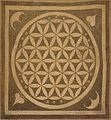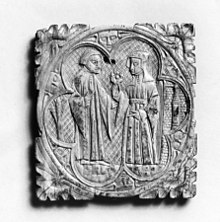
The hexafoil is a design with six-fold dihedral symmetry composed from six vesica piscis lenses arranged radially around a central point, often shown enclosed in a circumference of another six lenses. It is also sometimes known as a "daisy wheel". A second, quite different, design is also sometimes referred to by this name; see alternate symbol.
The design is found as a rosette ornament in artwork dating back to at least the Late Bronze Age.
Construction

|
| The seven overlapping circles grid forms a triangular lattice, seen here with hexagonal rings of 1, 7, 19, 37, 61, 91 circles. |
The pattern figure can be drawn by pen and compass, by creating seven interlinking circles of the same diameter touching the previous circle's center. The second circle is centered at any point on the first circle. All following circles are centered on the intersection of two other circles.
The design is sometimes expanded into a regular overlapping circles grid. Bartfeld (2005) describes the construction: "This design consists of circles having a 1- radius, with each point of intersection serving as a new center. The design can be expanded ad infinitum depending upon the number of times the odd-numbered points are marked off."
Usage
The hexafoil has been very widely used throughout European folk art for a very long period of time. It is attested from at least the beginning of the Late Bronze Age, represented, for example, on ornamental golden disks found in Shaft Grave III at Mycenae (16th century BC). It is also found in some Cantabrian stelae, dated to the Iron Age, as well as Norwegian bronze kettles from the same period
The six-petal rosette is common in 17th to 20th century folk art throughout Europe.
In Portugal, it is common to find it in medieval churches and cathedrals, as the engraved signature of a mason; but also as decoration and symbol of protection on the chimneys of old houses in Alentejo (at times together with the lauburu, or with the pentagram).
In Galicia (Spain) and all the Cantabrian Mountains, hexafoils are found since the Iron Age in torc terminals and decoration, and is still used in folk art.
It can also be found in the Pyrenees (Navarre, Aragon, and Catalonia). Since 2003 the hexafoil is being used as the logo of the Alt Pirineu Natural Park, the largest of Catalonia.
In the United Kingdom the hexafoil is commonly found on churches, but also in barns and private buildings, as well as on cross slabs. The use of the hexafoil as a folk magic symbol was brought from the United Kingdom to Australia by settlers, where six leaf designs with concentric circles have been found in homes and occasionally in public buildings to serve as a sign of protection.
The hexafoil was also widely used on gravestones in Colonial America, especially popular in parts of Connecticut, Massachusetts, and Pennsylvania. The design was commonly used from the later 17th century until the early 19th century.
The design is also known as "Sun of the Alps" (Sole delle Alpi) in Italy from its widespread use in alpine folk art. It resembles a pattern often found in that area on buildings. It is used in the coat of arms of Lecco Province. It has also been used as the emblem of Padanian nationalism in northern Italy since the 1990s. In 2001, Editoriale Nord, the publishing company of La Padania, registered the green-on-white design as a trademark.
In Norway it can mostly be found on wooden objects, such as beer bowls, clothes smoothing boards, milk butts, wooden chests, beds, and so on, but it can also be found on the doors of buildings. In Norwegian it's sometimes known as "Olavsrose" (rose of Olaf), although that name is used for another symbol as well.
In Lithuania the hexafoil was found on wooden beer bowls, spindles, and other wooden objects. It is known as "little sun" (saulute) in Lithuanian.
In the Tatra mountains, southeastern Poland and western Ukraine, the mark was commonly carved on roof beams inside peasant huts. In Ukraine it was known as "the symbol of Perun" (Peruna znak) and "the thunder mark" (gromovoi znak).
In the Russian North the hexafoil was carved near the outside roof of peasant houses to protect them against lightning. The symbol was known as the thunder sign (gromovoi znak) or the thunder wheel (gromovoe koleso), and was associated with the thunder god Perun.
Gallery
-
 Khachkar with hexafoils, swastikas and sauwastikas in Sanahin, Armenia
Khachkar with hexafoils, swastikas and sauwastikas in Sanahin, Armenia
-
 Ornamented gold disks from Shaft Grave III at Mycenae (16th century BC), (Archaeological Museum, Istanbul)
Ornamented gold disks from Shaft Grave III at Mycenae (16th century BC), (Archaeological Museum, Istanbul)
-
 Nepali sicle (hasiya) with its carrier (khurpeto) carved with the Aryan Star/Flower of Life symbol
Nepali sicle (hasiya) with its carrier (khurpeto) carved with the Aryan Star/Flower of Life symbol
-
 Cup with Flower of Life motif from Idalion, Cyprus, 8th-7th century BCE (Museum of Louvre, Paris)
Cup with Flower of Life motif from Idalion, Cyprus, 8th-7th century BCE (Museum of Louvre, Paris)
-
 Flower of Life on a mosaic from Apaša (Ephesos)
Flower of Life on a mosaic from Apaša (Ephesos)
-
 Floor decoration from the palace of King Ashurbanipal, Northern Iraq, 645 BCE (Museum of Louvre, Paris)
Floor decoration from the palace of King Ashurbanipal, Northern Iraq, 645 BCE (Museum of Louvre, Paris)
-
 Mosaic floor from a bathhouse in Herodium, West Bank, Palestine, 1st century BCE
Mosaic floor from a bathhouse in Herodium, West Bank, Palestine, 1st century BCE
-
Roman-era mosaic, Domus dell'Ortaglia, Brescia, Italy 2nd century CE
-
 Cantabrian stele at the Monastery of Iranzu, Navarre, Spain
Cantabrian stele at the Monastery of Iranzu, Navarre, Spain
-
 Selection of carvings from the hillfort of Santa Trega, Galicia, Spain (La Tène period, c. 1st century BC)
Selection of carvings from the hillfort of Santa Trega, Galicia, Spain (La Tène period, c. 1st century BC)
-
 Detail of an Imperial Guardian Lion at the Gate of Supreme Harmony, Forbidden City, Beijing, China
Detail of an Imperial Guardian Lion at the Gate of Supreme Harmony, Forbidden City, Beijing, China
-
 Facade of the medieval church in Galdo degli Alburni, Province of Salerno, Italy
Facade of the medieval church in Galdo degli Alburni, Province of Salerno, Italy
-
 Hexafoils featured prominently on a Colonial New England gravestone carved by Obadiah Wheeler in Franklin Connecticut.
Hexafoils featured prominently on a Colonial New England gravestone carved by Obadiah Wheeler in Franklin Connecticut.
-
Facade of the church in San Domenico, Lucera, Province of Foggia, Italy (ca. 1300)
-
 ceiling beam displayed at the Rural Architecture Museum of Sanok (Poland) dated to 1681.
ceiling beam displayed at the Rural Architecture Museum of Sanok (Poland) dated to 1681.
-
 Masonry in casa Federici, Erbanno, Val Camonica, Italy
Masonry in casa Federici, Erbanno, Val Camonica, Italy
-
 Wall painting on the facade of farmhouse Runcata in St. Ulrich in Gröden, Ortisei, Val Gardena, South Tyrol, Italy
Wall painting on the facade of farmhouse Runcata in St. Ulrich in Gröden, Ortisei, Val Gardena, South Tyrol, Italy
-
 Green-on-white "Sun of the Alps" as used by the Lega Nord
Green-on-white "Sun of the Alps" as used by the Lega Nord
-
 Perun's sign as used within Slavic Native Faith
Perun's sign as used within Slavic Native Faith
-
 Logo of the Alt Pirineu Natural Park, Catalonia, Spain
Logo of the Alt Pirineu Natural Park, Catalonia, Spain
Origin
The origin and meaning of the symbol are not known, but many researchers have independently suggested that it is of religious origin, and very likely served as a protective symbol. There are two main theories for its meaning and origin.
Solar symbol
Peralta Labrador (1989) cites a proposal according to which the design in the La Tène (Celtic) period was a solar symbol associated with the god Taranis. Other researchers have also described it as a solar symbol, but no reasoning for this has been given. However, the Lithuanian ("little sun") and Italian ("sun of the Alps") names do suggest a solar origin.
Thunder wheel
Garshol (2021) suggests that the rosette is actually a wheel with spokes, and that it originally signified the Proto-Indo-European thunder god Perkwunos, later becoming associated with his various incarnations, such as Perun, Tarḫunz, Taranis, Thor, and Jupiter. The Russian and Ukrainian names of the symbol, as well as other more involved arguments, are given as rationale.
Alternate symbol

The name hexafoil is sometimes also used to refer to a different geometric design that is used as a traditional element of Gothic architecture, created by overlapping six circular arcs to form a flower-like image. The hexafoil design is modeled after the six petal lily, for its symbolism of purity and relation to the Trinity. The hexafoil form is created from a series of compound units, and exists as a more complex variation of the same extruded figure. Other forms similar to the hexafoil include the trefoil, quatrefoil, and cinquefoil.
The other hexafoil design is implemented in various Gothic buildings constructed in the 12th through 16th century. The traditional design is used in cloisters, triforiums, and stained glass windows of famous buildings such as Notre-Dame, Salisbury Cathedral, and Regensburg Cathedral. Stone cut-out hexafoils are displayed in a plate tracery style in the Salisbury Cathedral, creating a pattern along the triforium.
It can also be seen as a framing design in Bible moralisée. They are often rendered in red, blue, gold, or vibrant orange and surround biblical scenes in the bible. The hexafoil style of framing was often used in conjunction with architectural framing to provide the text with more depth, creativity, invention, and volume. Old Testament illustrations were surrounded by hexafoil frames while moralization depictions favored architectural frames.
See also
References
- ^ Easton, Timothy (2016). "Apotropaic symbols and other measures for protecting buildings against misfortune". In Hutton, Ronald (ed.). Physical Evidence for Ritual Acts, Sorcery, and Witchcraft in Christian Britain. Palgrave Historical Studies in Witchcraft and Magic. pp. 39–67. ISBN 978-1-137-44482-0.
- ^ Høyrup, J. (2000). "Geometrical Patterns in the Pre-classical Greek Area. Prospecting the Borderland between Decoration, Art, and Structural Inquiry" (PDF). Revue d'histoire des mathématiques. 6 (1): 5–58.
- Islamic Art and Geometric Design: Activities for Learning
- Bartfeld, Martha (2005). How to Create Sacred Geometry Mandalas. Santa Fe, NM: Mandalart Creations. p. 35., citing Drunvalo Melchizedek, The Ancient Secret of the Flower of Life (1999). The attribution of the term "Flower of Life" to Melchizedek (1999) is also found in Wolfram, Stephen (2002), A New Kind of Science, Wolfram Media, Inc. (published May 14, 2002), pp. 43 and 873–874, ISBN 1-57955-008-8 and in Weisstein, Eric W. (12 December 2002), CRC Concise Encyclopedia of Mathematics, Second Edition, CRC Press (published 2002), p. 1079, ISBN 1420035223.
- Excavated by Heinrich Schliemann in 1876. Schliemann, Mykenae (1878), pp. 165–172.
- ^ Garshol, Lars Marius (2021). "Olav's Rose, Perun's Mark, Taranis's Wheel". Peregrinations. 7 (4): 121–151.
- Romero, Bieito (2019). Simboloxía Máxica en Galicia. A Coruña: Baía Edicións. pp. 70–95. ISBN 978-84-9995-329-8.
- Ariel Golan, Prehistoric Religion: Mythology, Symbolism, (2003), p. 54.
- Abella, Jordi; Garriga, Marc (2023). "El cas de logotip del Parc Natural de l'Alt Pirineu". In Perarnau, Xavier (ed.). La integració del patrimoni immaterial en els espais naturals protegits. La sexafòlia a l’alt Pirineu (PDF) (in Catalan). Barcelona: Silene. pp. 26–27.
- Mysterious hexafoil markings in Australian homes point to hidden magical past, Nicole Dyer, and Damien Larkins, ABC News Online, 2017-02-22
- Evans, Ian J (November 2013). "Defence Against the Devil: Apotropaic Marks in Australia". Trust News Australia: 14.
- "Il significato del simbolo del Sole delle Alpi" (in Italian). Lega Nord. Archived from the original on January 12, 2014. Retrieved December 1, 2014.
- Ivano Dorboló (June 6, 2010). "The church of S.Egidio and the Sun of the Alps symbol". Storia di Confine – Valli di Natisone. Retrieved November 9, 2015.
- Ufficio Italiano Brevetti e Marchi Archived 2014-02-01 at the Wayback Machine, registrazione del simbolo del Sole delle Alpi. According to Rosanna Sapori of Radio Padania Libera, the trademark as of August 2010 was owned by Silvio Berlusconi, who would have obtained it in exchange for the bailout of the bankrupt Credieuronord bank «Vi racconto perché Bossi è prigioniero di Berlusconi» Il Riformista 28 August 2010.
- Areta Kovalska (October 10, 2018). "A Protection Symbol for the Home: The Six-Petal Rosette on the Crossbeams of Galicia". Forgotten Galicia. Retrieved 2021-12-27.
- ^ Ivanits, Linda J. (1989). Russian Folk Belief. M. E. Sharpe. p. 17.
- Simonett, Christoph (1965). Die Bauernhäuser des Kantons Graubünden. Verlag Schweizerische Gesellschaft für Volkskunde. pp. 224–226.
- Weiser-Aall, Lily (1947). "Magiske tegn på norske trekar". By og Bygd. 5: 127.
- Eduardo Peralta Labrador, Las estelas discoideas de Cantabria in: Estelas discoideas de la Peninsula Iberica (1989), pp 425–466, citing the opinion of José María Blázquez Martínez.
- Østmoe Kostveit, Åsta (1997). Kors i kake, skurd i tre (in Norwegian). Landbruksforlaget. p. 58.
- Hartop, Christopher; Norton, Jonathan (2008), Geometry and the silversmith: the Domcha Collection, John Adamson, ISBN 9780952432289,
The trefoil, quatrefoil, hexafoil, and octofoil, essential elements of Gothic architecture, all figure in medieval silver.
- Passmore, Augustine C. (1904), Handbook of Technical Terms Used in Architecture and Building and Their Allied Trades and Subjects, Scott, Greenwood, and Company, p. 178,
A geometrical figure used in tracery; it is composed of six lobes or parts of circles joining each other.
- Rugoff, Milton (1976), The Britannica encyclopedia of American art: a special educational supplement to the Encyclopædia Britannica, Encyclopædia Britannica Educational Corp., p. 636,
A geometrical figure with six lobes, used as the form of a silver platter or a wooden decorative panel.
- Laxton, William (1856). The Civil Engineer and Architect's Journal. Published for the proprietor.
- Griffith, William Pettit (1845). The Natural System of Architecture, as Opposed to the Artificial System of the Present Day. Gilbert and Rivington.
- Chiffriller, Joe (2002). "Tips & Tricks to Gothic Geometry" (PDF). New York Carver – via PBworks.
- "The World's Best Photos of hexafoil - Flickr Hive Mind". hiveminer.com. Archived from the original on 2018-11-12. Retrieved 2018-11-12.
- "Salisbury Cathedral". Khan Academy. Retrieved 2018-11-17.
- ^ Husband, Timothy B. (2008). The Art of Illumination: The Limbourg Brothers and the Belles Heures of Jean de France, Duc de Berry. Metropolitan Museum of Art, Yale University Press. p. 282. ISBN 9781588392947.
hexafoil in architecture.
- ^ "Microfilms and Fascimilies Database // Medieval Institute Library // University of Notre Dame". medieval-microfilms-and-facsimiles.library.nd.edu. Archived from the original on 2019-07-28. Retrieved 2018-11-12.
External links
- [REDACTED] Media related to Flower of Life at Wikimedia Commons
- [REDACTED] Media related to Hexafoils at Wikimedia Commons
